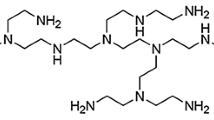Abstract
Purpose. To determine the electromigration and electroosmotic contributions to the iontophoretic delivery of lidocaine hydrochloride, in addition to the more-lipophilic quinine and propranolol hydrochlorides, in the presence and absence of background electrolyte.
Methods: In vitro experiments, using excised pig ear skin and both vertical and side-by-side diffusion cells, were performed as a function of drug concentration and with and without background electrolytes in the anodal formulation. Concomitantly, the contribution of electroosmosis in each experimental configuration was monitored by following the transport of the neutral, polar marker molecule, mannitol.
Results. Electromigration was the dominant mechanism of drug iontophoresis (typically representing ∼90% of the total flux). In the presence of background electrolyte, lidocaine delivery increased linearly with concentration as it competed more and more effectively with Na+ to carry the charge across the skin. However, iontophoretic delivery of quinine and propranolol increased non-linearly with concentration. Without electrolytes, on the other hand, electrotransport of the three drugs was essentially independent of concentration over the range 1-100 mM. Transport efficiency of lidocaine was ∼10%, whereas that of the more lipophilic compounds was significanly less, with the major charge carrier being Cl− moving from beneath the skin into the anodal chamber. Both quinine and propranolol induced a concentration-dependent attenuation of electroosmotic flow in the normal anode-to-cathode direction.
Conclusion. Dissecting apart the mechanistic contributions to iontophoretic drug delivery is key to the optimization of the formulation, and to the efficient use of the drug substance.
Similar content being viewed by others
REFERENCES
A. Kim, P. G. Green, G. Rao, and R. H. Guy. Convective solvent flow across the skin during iontophoresis. Pharm. Res. 10:1315-1320 (1993).
R. H. Guy, Y. N. Kalia, M. B. Delgado-Charro, V. Merino, A. López, and D. Marro. Iontophoresis: Electrorepulsion and electroosmosis. J. Control. Release 64:129-132 (2000).
A. Luzardo-Álvarez, M. Rodríguez-Fernández, J. Blanco-Méndez, R. H. Guy, and M. B. Delgado-Charro. Iontophoretic permselectivity of mammalian skin: characterization of hairless mouse and porcine membrane models. Pharm. Res. 15:984-987 (1998).
V. Merino, A. López, Y. N. Kalia, and R. H. Guy. Electrorepulsion versus electroosmosis: effect of pH on the iontophoretic flux of 5-fluorouracil. Pharm. Res. 16:758-761 (1999).
B. D. Bath, H. S. White, and E. R. Scott. Visualization and analysis of electroosmotic flow in hairless mouse skin. Pharm. Res. 17:471-475 (2000).
D. Marro, R. H. Guy, and M. B. Delgado-Charro. Characterization of the iontophoretic permselectivity properties of human and pig skin. J. Control. Release 70:213-217 (2001).
R. R. Burnette and B. Ongpipattanakul. Characterization of the permselective properties of excised human skin during iontophoresis. J. Pharm. Sci. 76:765-773 (1987).
M. J. Pikal. The role of electroosmotic flow in transdermal iontophoresis. Adv. Drug Deliv. Rev. 9:201-237 (1992).
http://www.bd.com/pharmaceuticals/products/transdermal/safety.html (visited Nov. 2000).
J. Hirvonen and R. H. Guy. Iontophoretic delivery across the skin: electroosmosis and its modulation by drug substances. Pharm. Res. 14:1258-1263 (1997).
M.B. Delgado-Charro and R.H. Guy. Characterization of convective solvent flow during iontophoresis. Pharm. Res. 11:929-935(1994).
M. B. Delgado-Charro and R. H. Guy. Iontophoretic delivery of Nafarelin across the skin. Int. J. Pharm. 117:165-172 (1995).
J. Hirvonen, Y. N. Kalia, and R.H. Guy. Transdermal delivery of peptides by iontophoresis. Nat. Biotech. 14:1710-1713 (1996).
J. Hirvonen and R. H. Guy. Transdermal iontophoresis: modulation of electroosmosis by polypeptides. J. Control. Release 50:283-289 (1998).
A. H. Hoogstraate, V. Srinivasan, S. M. Sims, and W. I. Higuchi. Iontophoretic enhancement of peptides: behaviour of leuprolide versus model permeants. J. Control. Release 31:41-47 (1994).
P. Glikfeld, C. Cullander, R. S. Hinz, and R. H. Guy. A new system for in vitro studies of iontophoresis. Pharm. Res. 5:443-446 (1988).
M. B. Delgado-Charro, A. M. Rodríguez-Bayón, and R. H. Guy. Iontophoresis of nafarelin: effects of current density and concentration on electrotransport in vitro. J. Control. Release 35:35-40 (1995).
G. B. Kasting and J. C. Keister. Application of electrodiffusion theory for a homogeneous membrane to iontophoretic transport through skin. J. Control. Release 8:195-210 (1989).
D. Marro, Y. N. Kalia, M.B. Delgado-Charro, and R. H. Guy. Optimizing iontophoretic drug delivery: identification and distribution of the charge-carrying species. Pharm. Res. 18:1708-1712 (2001).
P. M. Lai and M. S. Roberts. Epidermal iontophoresis: II. Application of the ionic mobility-pore model to the transport of local anesthetics. Pharm. Res. 15:1579-1588 (1998).
P. Santi and R. H. Guy. Reverse iontophoresis-parameters determining electroosmotic flow. I. pH and ionic strength. J. Control. Release 38:159-165 (1996).
Author information
Authors and Affiliations
Rights and permissions
About this article
Cite this article
Marro, D., Kalia, Y.N., Begoña Delgado-Charro, M. et al. Contributions of Electromigration and Electroosmosis to Iontophoretic Drug Delivery. Pharm Res 18, 1701–1708 (2001). https://doi.org/10.1023/A:1013318412527
Issue Date:
DOI: https://doi.org/10.1023/A:1013318412527




